What Counts as Climate?
Preliminary Evidence from the World Bank’s Climate Portfolio

-
-
Share
-
Share via Twitter -
Share via Facebook -
Share via Email
-
The World Bank is one of the largest providers of development finance to poor countries. In recent years, it has been under immense public pressure, mostly from its richest shareholders, to expand its climate portfolio. It has set ambitious targets to finance climate change mitigation and adaptation projects in low- and middle-income countries. As a result, its climate portfolio has undergone a significant expansion, especially after the publication in 2016 of the World Bank Group Climate Change Action Plan.
Too often, climate finance has become a proxy for climate outcomes when it comes to agenda-setting and strategy at the multilateral development banks. Over the last 18 months, the World Bank’s shareholders have led a major reform push that would have the Bank focus more on climate, with the discussion focused almost entirely on optimization of the institution’s balance sheet to scale up climate finance. Whatever the merits of this agenda, it should not proceed to the exclusion of a much more intensive focus on how the Bank is programming its climate finance. Previous reports from Oxfam and the Overseas Development Institute have asked important questions about the levels of funding and rebadging of flows. We build on this work to present evidence at the project level that suggests that the state of knowledge related to how the World Bank’s climate projects reduce emissions or help poor countries adapt to climate change is rudimentary at best.
We examine the World Bank’s climate portfolio of 2554 projects between 2000 and 2022. We look at the share of financing labeled as climate mitigation (projects that help limit climate change by reducing greenhouse gas emissions or removing greenhouse gases from the atmosphere) and climate adaptation (projects that help countries cope with present and future effects of climate change), and the corresponding amounts of money committed by the World Bank. We find that the Bank has a climate portfolio skewed towards mitigation, both in middle-income countries and in energy-poor, low-income countries. Further, hundreds of projects tagged climate—many in poorer countries—appear to have little to do with climate change mitigation or adaptation. A plain reading of these project documents sheds no light on why they are labeled as climate change projects.
Analysis of the data shows that the World Bank project selection does not appear to be guided by a strategy to help poor countries adapt to climate change. Adaptation—and its overlap with poverty reduction—is difficult to define, and the Bank has avoided any precise definition in project selection. Projects devoted solely to climate change are more likely focused on mitigation, even in poor countries with low emissions. The Bank only adopted adaptation-specific targets recently, reflecting a strategic preference for climate change mitigation during most of the period in which the institution has provided climate finance.
In sum, the evidence presented in this paper suggests the World Bank has a long way to go in demonstrating the value of its climate projects. The quality of project-level reporting to date raises questions about appropriate targeting of climate dollars, what counts or should count as climate adaptation, and the degree to which climate mitigation tagging can demonstrate a clear link to emissions reductions in every instance. External “pressure to lend” for climate could be exacerbating these problems and almost certainly creates internal incentives that prioritize volume over quality. Going forward, the Bank’s shareholders and climate advocates should apply more scrutiny to how the World Bank is spending climate money and not simply how it is raising it.
Method for data analysis
The Bank provides a detailed description of every project that it funds on a public database called the World Bank Projects Database. This database provides important information for a project—the amount of financing, the amount committed by the World Bank to the project, whether the financing was provided by the Bank’s market window (IBRD) or its concessional window (IDA), the approval and closing dates and the name of the implementing agency. The database also categorizes the project by themes, one of which is “environment and natural resource management.” Climate change is a subcategory of this theme, and the project database notes the percentage of project funding allocated to addressing climate change. The World Bank notes the following:
The climate change percentage (climate finance) shown under the Environment and Natural Resource Management Theme refers to the original amount of IBRD/IDA financing that was committed at Board approval stage. The World Bank estimates climate finance ex-ante, using the joint Multilateral Development Bank (MDB) methodologies for tracking climate finance in climate change adaptation and mitigation.
An example of this categorization is shown in Figure 1. In the example below, the project is tagged as 100 percent climate, with all of it devoted to climate adaptation. As a result, the entire dollar value of the project is attributed to climate adaption financing.
Figure 1
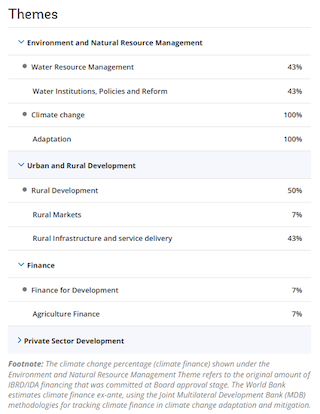
We examine 2554 projects that are tagged “climate change” out of a total of 12,000 projects. The projects have funding ranging from 1 percent of the loan allocated to climate to 100 percent of the loan. The next section describes the frequency distributions and corresponding funding for projects tagged from 1 percent to 100 percent climate, for the overall portfolio. The following section looks at the distribution of adaptation vs. mitigation projects in the Bank’s portfolio. We conclude with some observations on how the Bank can improve its work on climate.
The World Bank’s climate portfolio in numbers
The World Bank funded 2554 projects related to climate change between 2000 and 2022. Drawing on publicly available data in the World Bank Projects Database, Figure 2 shows funding by year, totaling $119 billion over the 23-year period. Figure 3 shows financing by the share of project funding allocated to climate change. Of the $119 billion in climate financing during the period 2000-2022, $37.4 billion was committed to projects solely focused on climate change. We have constructed frequencies and funding levels from the ground up. In aggregate, funding levels constructed in this way account for most, but not all, of the annual climate finance reported by the World Bank in recent years. Accounting for the discrepancy between official reported figures and figures constructed through the project database is beyond the scope of our analysis, though we do note that the project database for 2022 is incomplete, which could account for some, if not all, of the discrepancy.[1]
Figure 2
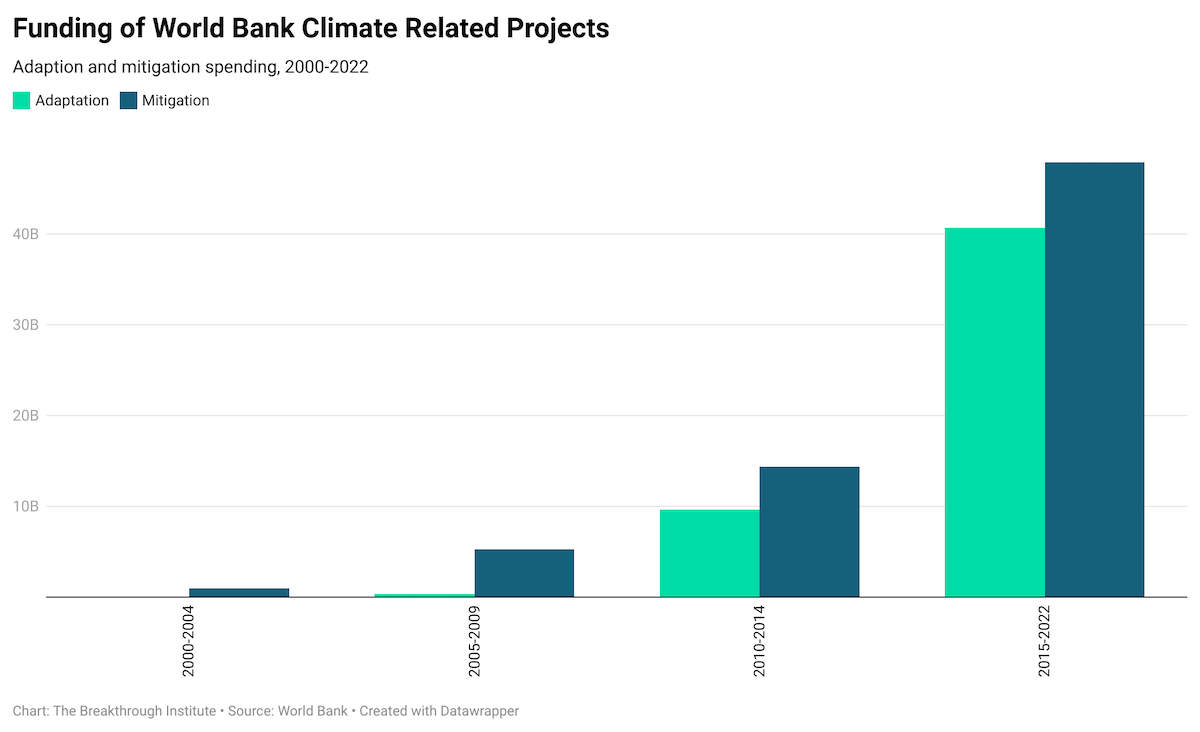
Figure 3
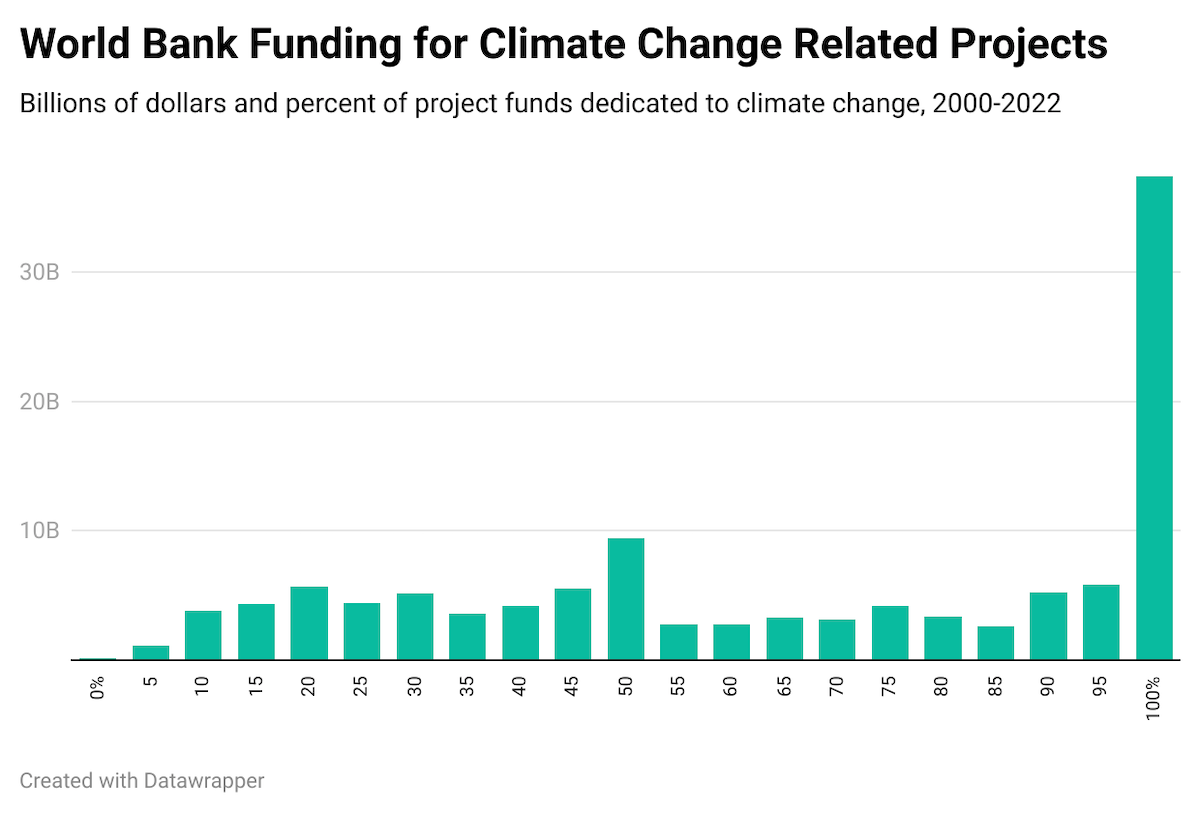
Until 2005, less than a billion dollars a year was committed to climate, entirely to mitigation. Over the next five years, about $5.5 billion was committed to climate change, with $5.2 billion of that going to mitigation. Between 2010 and 2014, the World Bank ramped up its climate portfolio to just over $22 billion. In 2016, the World Bank Group Climate Change Action Plan was announced. Funding for climate increased significantly, to almost $84 billion for the period 2015-2022.
Broken down by the percentage of the project allocated to climate change, Figure 3 shows that more than $37 billion was committed to projects tagged 100 percent climate over the period 2000-2022.
Skew towards mitigation and lack of targeting across countries
The Bank’s Climate Change Action Plan established a new target starting in 2021, that “at least 50%” of climate finance to IDA and IBRD countries would be for adaptation. Prior to this, adaptation was not an established priority, which is shown clearly in the data. As a result, a majority of the 2554 climate projects focus on climate mitigation. We find 1179 projects focused solely on mitigation, 507 solely on adaptation, and 868 on both. The total amount of funding towards mitigation was $68.7 billion, while that for adaptation was $50.7 billion. Figure 4 shows the total amount of funding for mitigation and adaptation by income category. For mitigation, low-income countries received $11.1 billion in financing, while middle income countries received $29.8 billion. High-income countries got $16.8 billion and the highest income countries (with income over $20,000) got $7.1 billion. Levels of funding for adaptation are lower. Low-income countries got $12.5 billion, middle-income countries got $25.3 billion, and higher-income countries got $9.1 billion.
Figure 5 shows the share of funding allocated for climate change by income category. In poorer countries, a smaller share of project funding is allocated for climate, whether it be adaptation or mitigation. For higher-income countries, we see large shares of project funding for climate mitigation. Figure 6 follows this same pattern: the amount of project funding for climate is also significantly larger in richer countries. Figure 7 shows the project count (the number of projects with a climate tag) by income category.
In principle, we would expect to see a greater concentration of mitigation projects in middle-income countries and adaptation projects in low-income projects, reflecting the relative distribution of climate emissions. Yet, there does not appear to be much difference in what the Bank does in low-income versus middle-income countries. Adaptation projects are not particularly focused on poorer countries and overall, there are few large adaptation projects.
We may expect to see greater differentiation by country income levels going forward, given explicit recognition for adaptation finance needs in poorer countries in the 2021 Climate Change Action Plan. As it stands, the Bank’s climate portfolio does not target resources to ensure that mitigation financing is going where potential gains in emissions reduction are greatest. In turn, the portfolio fails to target adaption financing where the needs are greatest. These project-level findings are consistent with analysis of official climate reporting, which also points to the lack of differentiation. Further, the lack of appropriate differentiation between low- and middle-income countries likely inhibits needed energy investments in very low-emitting poor countries.
Figure 4
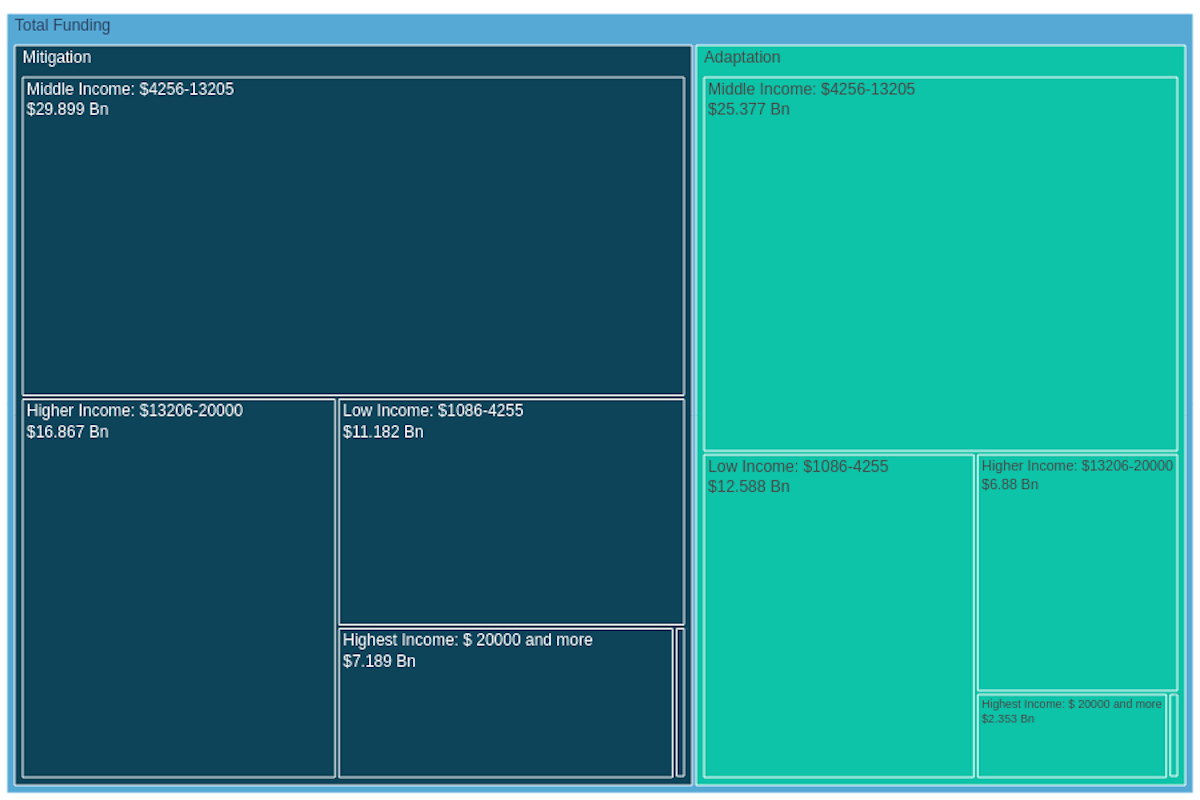
Figure 5
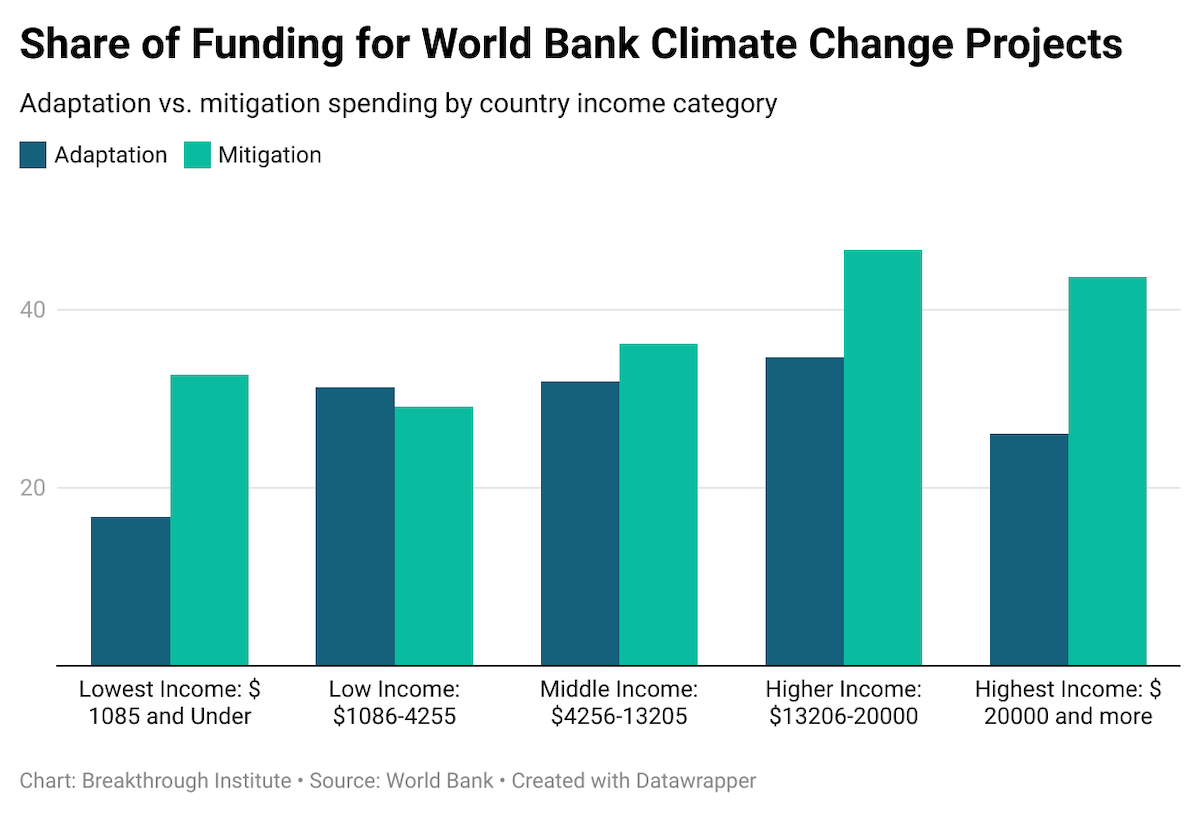
Figure 6
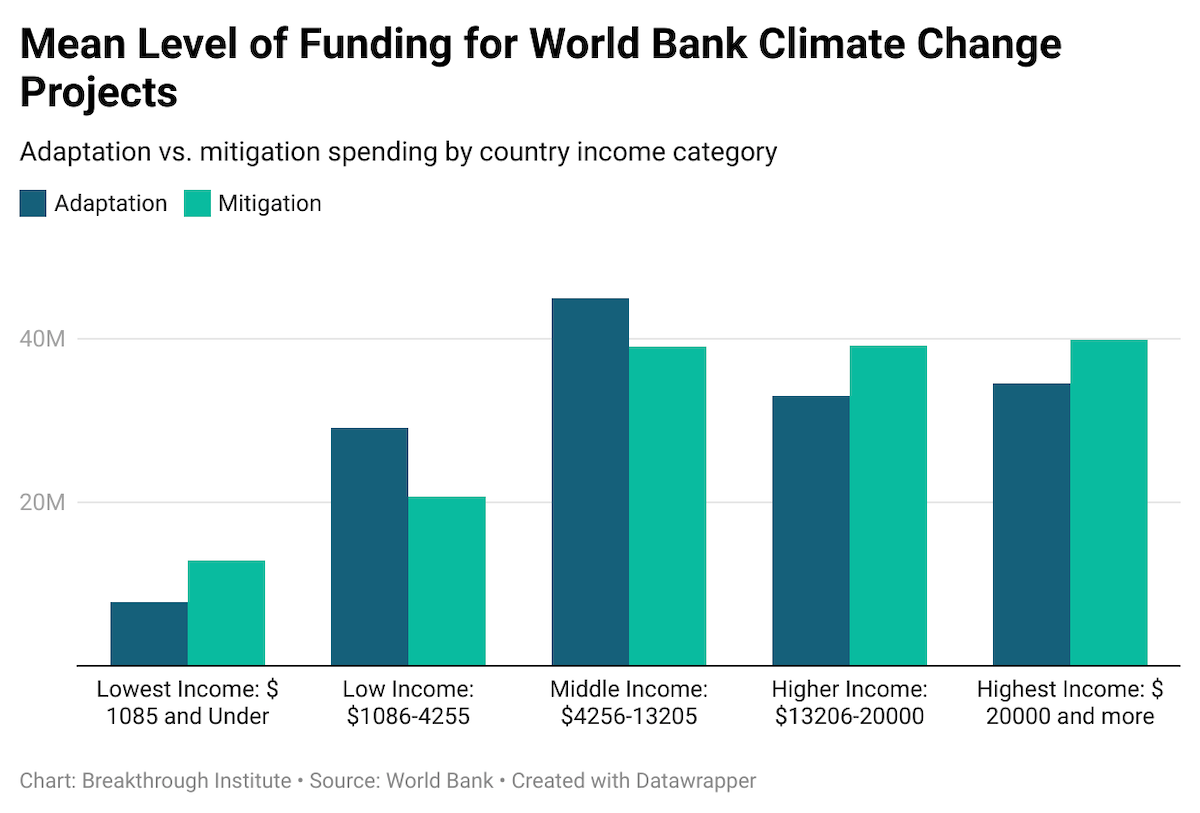
Figure 7
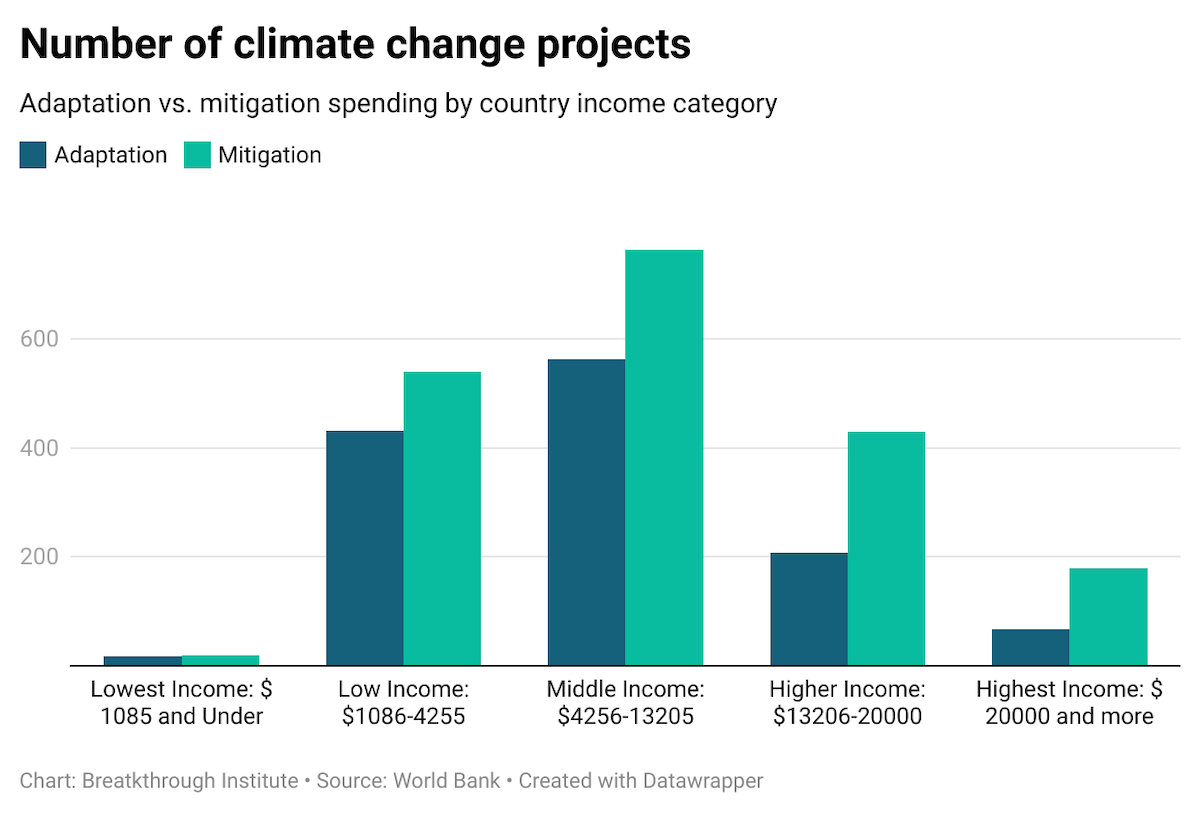
Small climate shares in many projects
We now turn to the labeling of projects. We find a significant number of projects where climate accounts for a small share of the project’s value, with little or no justification for the climate element of the project. This ambiguity in labeling is particularly problematic for climate mitigation, which ought to be linked directly to quantifiable emissions reduction. Where climate adaptation tags are ambiguous, the problem appears to reflect the lack of clear definitions or parameters guiding the Bank’s adaptation activities.
Appendix A lists 829 unique projects that are tagged as 20 percent climate or less. While some projects focus on natural resource management or environmental services, a plain reading of project summaries and documents shows that several hundred of these projects, including in poorer countries, do not show a clear link to climate change. Projects on employment in small and medium enterprises, tax reform, financing of health systems, payments systems and financial access, social protection systems, COVID-19 response, digital ID, digital government services, child health, early childhood development, public utility reform, macroeconomic and fiscal reform, or trade logistics are tagged with the climate change label. In some cases, the reason for tagging the project as climate might be inferred from the project summary by a creative reader.
Take, for example, education. There are 142 unique education projects that are tagged with a climate label. These include projects that focus on teacher training, education governance, student assessment, education financing, standards, curriculum and textbooks, private sector delivery of education, or access to education. It is not clear why any of these projects have a climate tag, and their abstracts make no reference to climate change. Of these projects, 114 are tagged as climate mitigation, 109 as adaptation.
For example, the abstract for the Guyana Education Sector Improvement Project (P159519)—tagged with 6 percent of its funding for climate adaptation—is as follows:
The development objectives of the Education Sector Improvement Project for Guyana are to: (i) improve teaching practices and student achievement in mathematics at the primary level in selected schools; and (ii) strengthen the teaching capacity and improve the learning environment of the University of Guyana (UG) faculty of health sciences (FHS). The project comprises of three components. The first component, integrated curriculum reform objective is to improve student achievement at nursery, primary, and lower secondary levels. It consists of following sub-components: (i) curriculum framework and teaching guides; (ii) teacher training; (iii) national assessment capacity; and (iv) teaching and learning materials. The second component, strengthening the teaching capacity and improving the learning environment for the UG FHS will support the UG FHS in achieving and maintaining regional accreditation for programs through improved and sustained teaching quality and learning environment. It consists of following sub-components: (i) strengthening teaching capacity; and (ii) improving the learning environment. The third component, project implementation support will support: (a) project coordination, implementation, and administration, including inter alia, the carrying out of monitoring and evaluation, procurement, financial management and environmental and social activities, and project audits; and (b) capacity building activities on project implementation.
The project development objectives are listed as (1) number of schools implementing a revised curriculum in the core subjects at the primary level and (2) increase in the percentage of pilot schoolteachers meeting standards in student-centered teaching practices. There are nine intermediate results indicators described but none mention climate change. Three project documents refer to climate change. A project appraisal document written in April 2017 mentions Guyana’s vulnerability to climate change. A document titled “Education Climate Change Co-benefits Case Studies” dated October 2018 concludes that an allocation of $0.75 million “demonstrated which specific design measures the school buildings constructed under the project would incorporate, to improve their resilience to the relevant climate change and disaster risks. The project could have increased its adaptation and/or mitigation co-benefits if it had incorporated content on climate change actions in the curriculum and teacher training.” A financial audit in 2018 also mentions climate. After that, we do not find any references.
Similarly, there are some 188 public administration projects tagged with a climate label. Some are tagged at just 1 or 2 percent climate, and it is difficult to find a link to climate change. For example, the objective of the Payments Automation and Integration of Salaries in Afghanistan Project (P168266) is “to support the development of digital government-to-person payments in Afghanistan.” There are four components to the project—a biometric identification system for civil servants and pensioners, safe cash withdrawal, cashless payments, and project management. The Second Municipal Development Project in Gaza (P155268) aims to “improve municipal management practices for better municipal transparency and service delivery.” One might infer from the project summary that it might help with adaptation to climate-related events, but the project is tagged as 6 percent mitigation. Yet, there is no stated rationale for the mitigation benefit, nor is there any indication of actual emissions reduction associated with the project, even at a de minimis level.
Some health projects have a climate tag, including several focusing on COVID-19 response. A maternal health project in the Democratic Republic of Congo is tagged as 5 percent climate. A project on jobs and exports in Bangladesh is tagged as 7 percent climate (4 percent mitigation, 3 percent adaptation), presumably because firms are being assisted with meeting international environmental and social quality standards.
While we can probably infer an adaptation co-benefit, it is much harder to understand why 114 of the 142 education projects have a mitigation label. For projects of this sort, it is fair to expect the World Bank to provide a “plain reading” justification for their climate elements. Further, the methodological annexes of the 2020 MDB Joint Report on Climate Finance say that a chain of causality should be established. Annex B titled “Joint Methodology for Tracking Climate Change Adaptation Finance” outlines three steps:
- Setting out the climate change vulnerability context of the project
- Making an explicit statement of intent of the project to reduce climate change vulnerability
- Articulating a clear and direct link between specific project activities and the project’s objective to reduce vulnerability to climate change
The report goes on to say that the identification and estimation of adaptation finance “is limited solely to those project activities that are clearly linked to the climate change vulnerability context.”
Similarly, the tracking of mitigation finance is based on the Common Principles for Climate Mitigation Finance Tracking. Appendix C of the 2020 MDB report lays out the nine principles. The text on mitigation results (#6) states the following:
“any inclusion of climate change impacts is not a substitute for project-specific theoretical and/or quantitative evidence of GHG emission mitigation. Projects seeking to demonstrate climate change impacts should do so through project-specific data.”
If it has been established in cases like those just identified, the chain of causality or any sort of climate rationale appears to be absent from the core project information. This is problematic for projects where the climate share accounts for a small, and even de minimus, share of the project’s value. This problem by no means plagues the entirety of the World Bank’s climate portfolio. But $15 billion of the portfolio over the reporting period is comprised of projects where climate accounts for 20% or less of the project’s value. The failure to provide any supporting documentation or rationale for the climate tag in many of these cases calls into question their legitimacy.
This problem extends to projects that are entirely devoted to climate mitigation. Appendix B lists 464 unique projects tagged 100 percent climate change, including on topics such as environmental management, emergency response and disaster reconstruction, sustainable rural development, renewable energy generation including solar, hydro, geothermal and wind, irrigation modernization, and emissions reduction. These projects are heavily skewed towards mitigation—only 103 projects are tagged as climate adaptation. Many of the projects are in East and Southeast Asia and Eastern Europe but there are projects in other regions as well. One example is the Eastern Dedicated Freight Corridor Project for India, where the World Bank is providing $975 million in financing to increase rail transport capacity, improve service quality, and achieve higher freight throughput on the 343 km Khurja-Kanpur section of the eastern rail corridor. The project also improves the institutional capacity of the Dedicated Freight Corridor Corporation to build and maintain infrastructure.
Most projects on the list lack estimates of greenhouse gas (GHG) emissions reductions, and there is no standardized reporting on GHG estimates across the portfolio. A plain reading of documents for projects labeled greater than 75 percent climate in FY22 revealed only six projects had such estimates. Other project documents mention emissions reductions but provide few details. As such, it is impossible to verify the Bank’s claim of emissions reductions of 194 tCO2 eq/year for FY19 to FY22. The lack of climate reporting in the portfolio is troubling, given the increasing amounts of money spent on mitigation.
Climate “Talk” Versus Climate Action
To illustrate these reporting problems further, we developed a normalized term density score which measures how many times the term “climate change” is mentioned in available project documents and compare that with the percentage of the project’s financing tagged as climate change. Cross-tabbing high (> 4 mentions per 10000 characters) and low term densities (<4 mentions per 10000 characters) with high (>75 percent) and low levels (<25 percent) of climate funding shows that 223 projects talk a lot about climate change and assign the funds accordingly, 180 talk a lot about climate change, but do not assign very much money, 816 do not talk a lot about climate and do not assign a lot of funds, and 523 projects do not talk a lot about climate but assign over three quarters of project funding to climate (Figure 8). In sum, there is very little in the project-level reporting that suggests a consistent approach to conveying the climate value of a project.
Figure 8
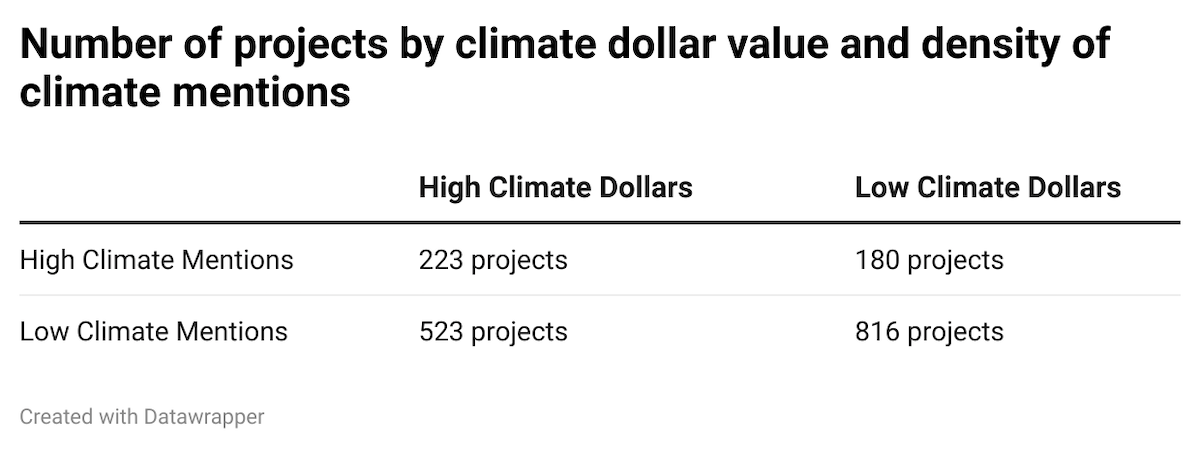
Recommendations
The non-trivial share of the climate portfolio associated with projects lacking any evident climate rationale raises the possibility that climate finance targets (and the dominant focus on these targets by shareholders) may be creating inappropriate incentives within the World Bank. Under considerable pressure to meet ambitious financing targets, and without clear definitions of mitigation and adaptation, Bank staff appear to attribute climate benefits in an ad hoc manner.
Projects labeled climate should be accompanied by project summaries and documents that contain a clear explanation of why they mitigate emissions (with estimates of GHG reductions) or how they help increase resilience to weather or climate-related events. A plain reading of project documents should provide a clear rationale for the climate tag. For projects with low levels of tagging, an explanation of the climate co-benefits of the project is warranted.
The absence of data on GHG emissions in project documents means that it is impossible to verify overall figures on emissions reductions as reported by the World Bank’s Scorecard. As more money is directed to mitigation, the World Bank needs to provide high quality, transparent estimates of its impact on emissions and how the counter-factual is defined. The Bank might use standard coefficients for emissions associated with different technologies such as wind, solar, geothermal, hydro etc. It might also want to invest in basic models that estimate the economic rate of return for investing in renewables. If there an internal database that is being used to aggregate emissions reductions, this should be made public.
For projects in education, health, etc. that appear to have no relationship to climate mitigation, the Bank must explain its reasoning. If the argument is that educated people are more climate aware or innovate more to reduce carbon emissions, this should be made explicit. It might also be useful to distinguish between direct and indirect effects, by grading the project’s co-benefits (low, moderate, high) rather than assigning an unverifiable and arbitrary number.
Likewise, the Bank must do more to identify outputs and verify outcomes for adaptation projects. An official and precise definition of adaptation from the Bank will likely reduce ad hoc labeling. The Bank may choose to define climate adaptation projects narrowly to include only those that directly address the consequences of some observed or anticipated change in climate.
Alternatively, the Bank could argue that general economic development has major climate resilience co-benefits. It is empirically true that general economic development is strongly associated with decreased vulnerability to climate: stronger and more resilient infrastructure (including paved roads, access to electricity, and access to running water), better zoning and building codes, more sophisticated early warning systems, better-equipped first responders, and more capable healthcare systems. To the extent that, say, increased educational attainment increases human capital and thus general economic development, it could be argued that an investment in education is indeed an investment in climate resilience. Development may not be functionally distinct from adaptation; understanding its role in improving climate resilience might reduce false choices between “climate” and “non-climate” projects. If this assumption does underlie the Bank’s decision to categorize projects as climate-related, however, it should make the argument explicitly.
A transparent and clearly articulated rationale for mitigation and adaptation at the project level, along with data that can be verified, would address some of the reporting problems identified in this paper. But the more fundamental problem reflected in this evidence is one of priorities. Attributing 1% of a project’s value may help the Bank meet its finance targets, but it inspires little confidence about the institution’s real value in addressing climate change. So long as climate finance is viewed as an outcome in and of itself, operational incentives within the World Bank will be misaligned with the ultimate climate goals: ensuring that Bank financing is demonstrably delivering emissions reductions in high-emission countries and effective adaptation strategies in the poorest and most vulnerable countries.


